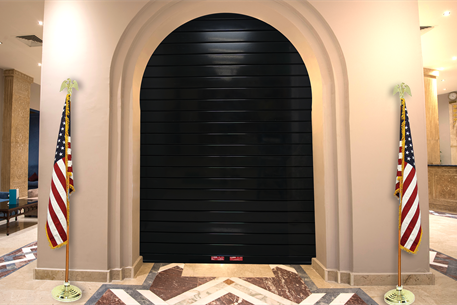

Cornell Commercial Rolling Doors and Security Grilles Blog
When it comes to Overhead Rolling Doors and Grilles, we are the experts in innovative door solutions!
Subscribe
Get updates on new blog posts to your inbox!
Federal Facility Security or Bust: Featuring EntryDefender®
Understandably, government buildings require a higher level of security than your average structure. Due to the nature of their business, government buildings may be more prone to break-ins, theft, and damages— especially because they house confidential information, whether in the form of paper records or in the minds of valuable employees.
What is federal facility security?
Federal facility security has been top of mind for as long as the U.S. has had an established government, from 1814, where British citizens burned the Capitol and White House to 1998, where an armed assailant rushed past a security checkpoint, mortally wounding two Capitol police officers. And the Capitol isn’t the only one that’s been targeted: postal offices, city halls, courthouses, public transport buildings, and more have been ringed with bull’s-eyes for centuries.

The Congressional Research Service defines federal facility security as including “operations and policies that focus on reducing the exposure of a facility, employees, and the visiting public to criminal and terrorist threats,” and lists five security levels used to classify federal facilities, which are:
- “Level I—buildings with no more than 2,500 square feet, 10 or fewer federal employees, and limited or no public access;
- Level II—buildings with 2,500 to 80,000 square feet, 11 to 150 federal employees, and moderate public access;
- Level III—buildings with 80,000 to 150,000 square feet, 151 to 450 federal employees, and moderate to high public access;
- Level IV—buildings with 150,000 square feet or more, more than 450 federal employees, and a high level of public access; and
- Level V—buildings that are similar to Level IV but are considered critical to national security (e.g., the Pentagon).”
Are there clear-cut security door requirements for government buildings?
The requirements are more stringent when specifying security roll-up doors for government buildings. There isn’t a one-size-fits-all requirement for these buildings, particularly because the threats can range from break-ins and civil disturbances to arson and homicides. Different security measures must be taken into account when designing a government facility.
Perhaps one of the easiest items to specify starts at the threshold—literally. To stop a siege in its tracks, fortify entry points with security doors made to withstand attacks with the testing to prove it.
EntryDefender: Stopping Attacks Before They Start

Cornell’s EntryDefender® Door is ideal for government buildings, pharmaceutical and cannabis dispensaries, manufacturing facilities, and other spaces that need heightened levels of security. Its steel curtain is designed to protect against attacks for 5, 15, and 60 minutes in accordance with the U.S. Department of State Standard for Forced Entry SD-STD-01.01, Revision G (Amended).
According to the Certification Standard, SD-STD-01.01, Revision G “sets forth the requirements and testing procedures to certify forced entry (FE) systems which are intended for use by the U.S. Department of State (DOS) in its facilities throughout the world. The certification of FE systems is mandatory and indicates that the systems will provide the level of FE protection required by DOS standards for specific facilities in certain threat environments.”
EntryDefender is the only steel door in the U.S. certified to meet this standard on the market. Its proprietary design includes interlocking slats that compress in the closed position, creating a smooth surface that engages to further prevent separation the longer an attack goes on. This also lessens the potential of pry points to latch onto for determined attackers, dashing plans to thwart governmental business and meetings.

EntryDefender may give the appearance of a standard rolling door, but it’s anything but. Designed for a static wind load of up to 125 psf and to operate to 20,000 cycles (lifetime) as standard, EntryDefender is a sure choice when looking to specify a security rolling door that offers the utmost protection for facilities that need it most.
Get Security Doors for Your Government Facility
For the particulars on EntryDefender, including material and finish options and more details, visit our product page.
For more information on our EntryDefender Door and how it can fit into your specification, contact us today.





